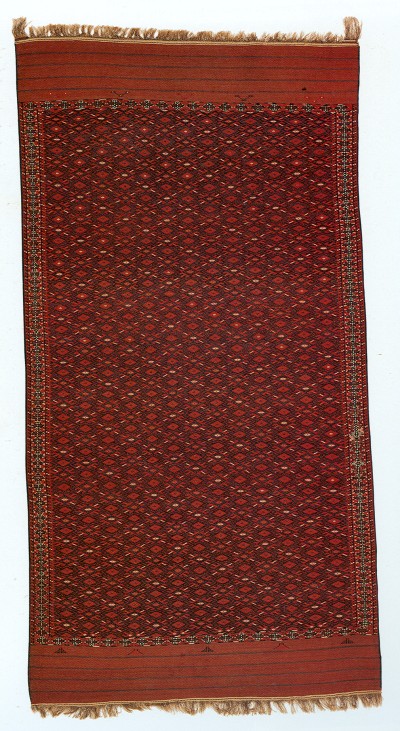Posted by David R.E. Hunt on 03-22-2005 06:29 PM:
Oversize Palas Images
Everyone
Please follow the following link to some
oversize images
of this Turkmen Palas It's large size, at approx 6.5 ft x 13.5 ft,
makes it difficult to photograph (at least for me ). The lower image is a better
approximation of color, but the large size in combination with this rather
"active" pattern do render it somewhat transmutable.
). The lower image is a better
approximation of color, but the large size in combination with this rather
"active" pattern do render it somewhat transmutable.
Dave
Posted by Tim Adam on 03-23-2005 01:10 AM:
Dear David,
Thanks for putting up an interesting salon.
All
the Turkmen flatweaves that I have seen so far seem to be quite recent (20th
century). Maybe the only exception are those "fish bone" design (not sure
whether this is the generally accepted name) flatweaves. So, I am wondering
whether there are any published examples, that could be significantly older, say
pre 1850s? Or, are Turkmen flatweaves a completely recent
phenomenon?
Regards,
Tim
Posted by Steve Price on 03-23-2005 08:11 AM:
Hi Tim
I think attribution of Turkmen flatweaves is pretty much
uncharted waters. This is true for date and for tribal origin.
Like you,
most of the ones I've seen are fairly obviously recent. I suspect that this is
at least partly due to the fact that nobody much cared about Turkmen flatweaves
until fairly recently (in fact, not many people care about them today), and many
older ones were probably discarded as trash long
ago.
Regards
Steve Price
Posted by Richard Tomlinson on 03-25-2005 12:15 PM:
Hi Steve
You wrote;
"I suspect that this is at least partly due
to the fact that nobody much cared about Turkmen flatweaves until fairly
recently (in fact, not many people care about them today), and many older ones
were probably discarded as trash long ago."
I would argue that, in
general, piled pieces have always been more highly valued than flatweaves. And
yet kilims from a wide group of weavers have survived. We have a lot of of
Moroccan, Anatolian, Kurdish, Caucasian, Afghan, and Persian kilims.
Why
then would there not be at least a reasonable group of Turkmen kilims that are,
say 100+ years old? Perhaps there are?It is not my area, but I have not seen
many OLD Turkmen kilims.
I suspect because they simply were not
made.
Regards
Richard Tomlinson
Posted by Steve Price on 03-25-2005 12:37 PM:
Hi Richard
That's a reasonable alternative explanation, and I think
it's the correct explanation for the rarity of old Turkmen prayer rugs. Bear in
mind, though, that many of the kilims made in those other areas were preserved
because they were donated to mosques by the local folks. As far as I'm aware,
this was not a Turkmen practice.
I'm not sure that the number of 100+
year old Turkmen flatweaves is trivial, although (like you) most of the ones
I've seen are probably pretty young. The Turkmen appear to have been using
synthetic dyes for more than 125 years.
It would be interesting to have
the results of a serious study of the factors leading to the preservation of
textiles in various cultures.
Regards
Steve Price
Posted by David R.E. Hunt on 03-25-2005 01:40 PM:
A Good Question...
Tim, Richard, All
I would imagine that those palas from the Weiderperg
Collection,

such as this one above, have as good a chance as any of being old. I
have seen a fair number of these palas in the market place over the years, and
most do seem to have been recent, but remember a particular example which was
said by the vendor to be antique and which struck me as singular,if memory
serves, due to it's large size and fine weave.
They do seem of a
utilitarian nature, and composed of materials
otherwise unsuitable for use as
pile weave. Reed screens
were/are used extensively in the past and present
(or at least plastic imitations) , yet old examples are rare.
I suspect
that the relationship which these palas share with loomed fabrics in general
could be both as instructive and interesting as the relationship between the
palas and Pilework.
Dave
 ). The lower image is a better
approximation of color, but the large size in combination with this rather
"active" pattern do render it somewhat transmutable.
). The lower image is a better
approximation of color, but the large size in combination with this rather
"active" pattern do render it somewhat transmutable. 